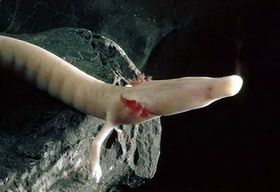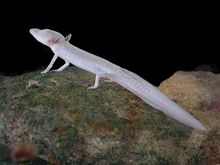
The olm or proteus is an aquatic salamander which is the only species in the genus Proteus of the family Proteidae and the only exclusively cave-dwelling chordate species found in Europe; the family's other extant genus is Necturus. In contrast to most amphibians, it is entirely aquatic, eating, sleeping, and breeding underwater. Living in caves found in the Dinaric Alps, it is endemic to the waters that flow underground through the extensive limestone bedrock of the karst of Central and Southeastern Europe in the basin of the Soča River near Trieste, Italy, southern Slovenia, southwestern Croatia, and Bosnia and Herzegovina. Introduced populations are found near Vicenza, Italy, and Kranj, Slovenia. It was first mentioned in 1689 by the local naturalist Valvasor in his Glory of the Duchy of Carniola, who reported that, after heavy rains, the olms were washed up from the underground waters and were believed by local people to be a cave dragon's offspring.

Brook salamanders are a genus, Eurycea, of salamanders native to North America.
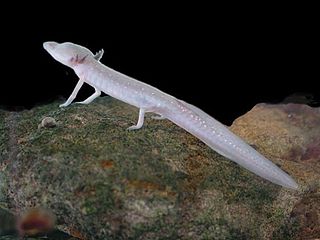
The Texas blind salamander is a rare and endangered cave-dwelling troglobite amphibian native to San Marcos, Hays County, Texas, specifically the San Marcos Pool of the Edwards Aquifer. This species resembles the olm, another stygofaunal salamander from Europe. Unlike the olm, this amphibian's body is not as elongated, and also has less reduced digits on its limbs.

The Cascade Caverns salamander, or Cascade Caverns neotenic salamander, is a species of aquatic salamander endemic to Cascade Caverns in Kendall County, Texas. Like other species of cave salamanders, they are almost entirely subterranean, living in spring waters deep in limestone rock strata, so gauging the exact extent of their geographic range or even their population numbers is virtually impossible. This also leads to reduced sampling for study, which has led to some uncertainty in the taxonomic classification; some sources consider all species of Texas cave salamanders to be subspecies of the Texas salamander. Eurycea neotenes and Eurycea rathbuni also live in caves and eat small insects and spiders.
The Comal blind salamander or Honey Creek Cave blind salamander is a small species of aquatic, lungless salamander native to the United States. It is endemic to a small region at the junction of Comal, Bexar and Kendall Counties in Texas. It is 1.5 to 3.0 in long, with a slender body and external gills, and is an overall translucent pink color.
The Blanco blind salamander is a species of aquatic, lungless salamander native to the United States. It is endemic to a small region of the Blanco River near San Marcos in Hays County, Texas. Its habitat, deep in limestone karst, makes collecting specimens for research particularly problematic. It is known from only a single specimen, collected in the 1950s.
Eurycea neotenes, also known as the Texas salamander, Bexar County salamander, Edwards Plateau salamander, or Texas neotenic salamander, is a species of entirely aquatic, lungless salamander native to the United States. It is endemic to central Texas, near Helotes, in Bexar County.

The Tennessee cave salamander is a species of salamander in the family Plethodontidae, endemic to the Appalachian Mountains in the United States. Its natural habitats are streams in caves. It is threatened by habitat loss.
The Georgia blind salamander is a species of salamander in the family Plethodontidae. It is endemic to the south-eastern United States where its natural habitats are inland karsts, caves and subterranean habitats. It is listed as "Endangered" by the IUCN and is threatened by habitat loss.

The western grotto salamander, also called the Ozark blind salamander and previously known as just the grotto salamander, is a species of salamander in the family Plethodontidae. It is endemic to the United States. Its natural habitats are freshwater springs, inland karsts, and caves. It is not currently threatened, but vulnerable to changes in groundwater quality and reduction in bat population.
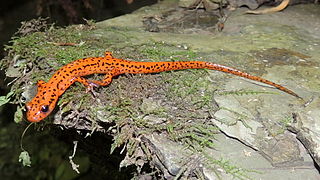
The spotted-tail or spotted-tailed salamander is a species of brook salamander in the family Plethodontidae. This species is, somewhat vaguely, referred to by the common name of 'cave salamander'; however, it is not restricted to dwelling inside deep caverns, but is known for inhabiting surface-level, terrestrial, woodland habitats, as well. More often than not, the common name 'cave salamander' refers to the "true" cave salamanders, such as the olm of Europe. It is rarely used to refer to the axolotl, another species which, like the olm, inhabits caves that never see daylight, thus lacking skin pigment and having extremely poor eyesight when compared with the vivid orange and bright-eyed spotted-tail salamander. Additionally, true cave salamanders, including the olm, spend their entire lives as fully-aquatic amphibians, while the spotted-tail salamander is not limited to an exclusively amphibious lifestyle.

The southern grotto salamander is a species of salamander in the family Plethodontidae. It is endemic to northern Arkansas in the United States.
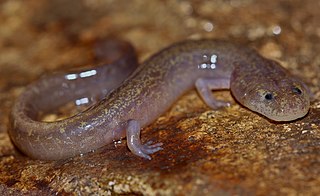
The northern grotto salamander is a species of salamander in the family Plethodontidae. It is endemic to the south-central United States.
Grotto salamander may refer to three species of troglobitic salamander in the genus Eurycea, all endemic to the United States and all of which were formerly considered a single species :
